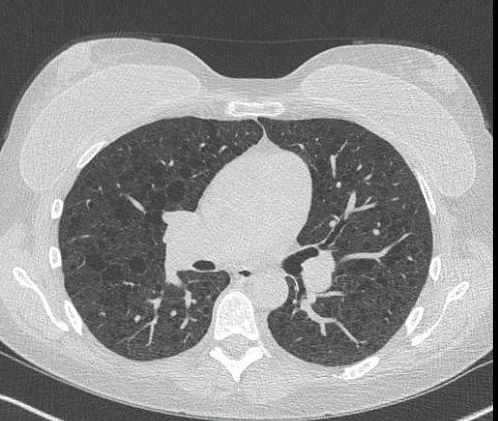A 51 y.o. woman comes in with shortness of breath
What do you notice on her PE protocol CT?
Our patient had tuberous sclerosis with cystic lung disease. There was no PE.
Tuberous sclerosis is a genetic disease that causes benign tumors to grow in the brain, lungs, kidneys, heart , skin, eyes and pancreas. It is caused by mutations in one of two genes: TSC1 or TSC2. These genes produce proteins that suppress tumors and when they are absent, tumors occur.
tubers in the brain on MRI
Tuberous sclerosis was first described by Bourneville in 1880 . He was a French surgeon who founded a day school for children with mental disability and noted a constellation of symptoms including seizures, mental disability and skin tumors which he named tuberous ( tuber from the Latin for swelling) and sclerosis (sklero from the Greek for hard).
The manifestations affect many organs. In the kidneys angiomyolipomas occur and polycystic kidneys in children may be the first manifestation of the disease. The disease in the lungs with multiple cysts is thought to be monoclonal metastasis from the renal angiomyolipomas which is why it has been reported after lung transplant.
Angiomyolipomas of the kidneys
Skin manifestations are found in 96% of individuals with tuberous sclerosis. Hypomelanic macules (ash leaf spots) , adenoma sebaceum( adenomas in a butterfly distribution on the face), Shagreen patches (thick skin patches dimpled like orange peel), and periungual fibromas are found in these patients.
Many of the findings of tuberous sclerosis are found in patients who do not have the disease. The lung cysts in isolation are called lymphangioleimyomatosis(LAM) . Tuberous sclerosis manifests differently in each patient with some patients like our patient with little symptomatology. She has mild obstructive lung disease and multiple kidney angiomyolipomas without renal failure and is followed periodically in clinic.
Henske EP. Metastasis of benign tumor cells in tuberous sclerosis complex. 2003 Genes Chromosomes and Cancer. 38(4):376-81.
Krueger D, Northrup H. International tuberous sclerosis complex consensus group (2013-10-01) Tuberous sclerosis complex surveillance and management: recommendations of the 2012 International Tuberous SclerosisComplex Consensus conference . (https://www.ncbi.nlm.nig.gov’pmc/articles/PMC4058297) Pediatric Neurology 49(4): 255-265.
Shepherd CW, Gomez MR, Lie JT, Crowson CS. Causes of death in patients with tuberous sclerosis. 1991 Mayo Clin Proc 66(8): 792-6.
Rakowski SK, Winterkorn EB, et al. Renal manifestations of tuberous sclerosis complex: Incidence, prognosis and predictive factors. 2006. Kidney Int 70(10):1777-82.
adenoma sebaceum




